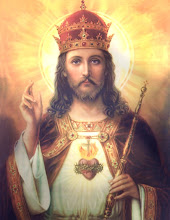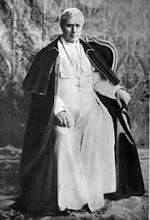My article “Tradición y modernismo en la Iglesia”, previously published in Spanish in the Portuguese digital journal Alameda Digital, has been now translated into English thanks to the good efforts of TTony, of The Muniment Room,
As we have a few readers who are from English-speaking countries, it will help those of “tolkienian” and/or “chestertonian” disposition and persuasion in linguistic matters.
We reproduce here this entry of The Muniment Room
Once more, thanks to TTony.
The very essence of the Church demands continuity between Jesus Christ, Our Lord and Saviour, and our times. So those who call themselves “Christians”, but who have broken this continuity, cannot be part of the Church. Neither Lutherans, nor Calvinists, nor Methodists, nor members of any Protestant sect, are part of the Church, however much they might claim to be.
The Catholic Church doesn’t just have a 2000 year history of real and effective existence: it actually has a 6000 year history, because the Old Testament Prophecies are fulfilled in Christ. All of Judaism pours out into Christ, however little the Jewish people see it. In fact Judaism, in order to survive into modern times, has to drink deeper from the Talmud than from the Old Testament, and the Talmud was compiled after the time of Christ. As many theologians have noted throughout history, the new Israel – the chosen people – is the Catholic Church. A marvellous book called “How Jesus Christ Said the First Mass” explains how the institution of the Eucharist and the Mass at the Last Supper thrusts its roots deeply into the Sacred History of the Old Testament. Many of the things which take place prefigure the third and definitive Revelation which is of God himself: Christ.
Of course none of this is possible without the existence of Tradition, a deposit of Faith, Doctrine and Liturgy which is passed from generation to generation and which is changeless. The Faith requires some basic assumptions, which we call Dogmas, and which Catholics have to believe if they are going to continue to be Catholics. Dogmas are immutable, as is the Faith. Of course it is possible to make clearer something which is implicit in Doctrine: for example, the proclamation of the Dogma of the Immaculate Conception happened in the nineteenth century, but there is evidence that this feast was celebrated as early as the third. One of the authors who writes most clearly about this is Fr Juan González Arintero OP, who in the three volumes of “Development and Vitality of the Church”, and in his “Mystical Evolution” explains how the development of doctrine is organic, yet does not introduce novelties or, even less, contradictions.
The best expression of the biblical saying “one Faith and one Shepherd” is the Mass codified by Pope St Pius V. There are several Catholic rites, but they have always shared three nuclear aspects which come from Tradition: the Canon, the Offertory and the Consecration. Various additions were made to this foundation through the centuries, because Tradition is not about stagnation, but about sensible, accurate, thought-through, organic progress. The Roman Canon codified this one Faith – while respecting venerable Rites such as the Hispano-Visigothic (often referred to inaccurately as the Mozarabic Rite), the Rite of Braga, or the several eastern Catholic Rites. Pope St Pius V accepted that the Mass could be added to in the future, as happened with the Leonine prayers to St Michael at the foot of the altar. But “Anathema Sit” was hurled at those who would change what was codified: modification of the Canon of the Mass, which had been sealed by the Holy Pope at a time when the enemies of God and His Church moved towards their high tide, could not be accepted.
It is Tradition which links us directly to the time of the Apostles and to Our Lord himself. Because if Christ instituted One Church, the Catholic Church, it is no less certain that He gave it the power to bind in Heaven: Tradition means respect for the past, the impossibility of a rupture with the past. Pope St Pius V codified the Mass, and there is no human nor angelic power able to change this dogmatic statement. Nobody, not even the Holy Father himself, can change a dogma which has been proclaimed. As Chesterton said: “Tradition is the democracy of the dead”. And as the Church has three parts (the Militant, the Suffering and the Triumphant) we have no right to attack the link which, across time, unites those of us who are alive on Earth with those who live in the hereafter. The democracy of the dead has one of its axes in Christ, and is therefore theocentic.
The modernist proposes that all our principles and our dogmas should be adapted to the spirit of the times, the Zeitgeist. Modernism, which Pope St Pius X called “the sewer of all heresies” empties the Faith of content because it empties dogmas of content. Although there has to be an intimate connection between Faith and Liturgy, modernism has managed to make of the Catholic Liturgy of today a multiple, chaotic, changeable and ugly thing, which reflects the philosophy which inspires it.
Grass doesn’t grow beneath the feet of the modernist, because he might cut it at any moment. In modernism, the axis is no longer centred in Christ: it has become anthropocentric. Modernism is, therefore, immanentism.
And a word about that weak creature that can be seen here and there: the Vatican II conservative. He is not a defender of Tradition. He is somebody who has accepted some of the precepts of the Revolution while rejecting others. He wants to freeze the Revolution at point that suits his interest or his convenience. He wants to preserve odd remnants of the Traditional order of things, even though they may already have been emptied of content or meaning. Unlike the Traditionalist, the Vatican II conservative is stagnant, even though, much to his discomfiture, he is permanently surfing the waves of Revolution. He is disguised as a chameleon.
If the liberals are high speed anthropocentrists, the Vatican II conservative is a low profile anthropocentric: but they are still both anthropocentrists.
Neither those who openly favour rupture with the past: the modernists; nor those who tacitly allow it to happen: the Vatican II conservatives; belong in Christ’s Church. The Mystical Spouse of Our Lord admits neither circumlocution nor compromise. The Mystical Spouse is outside time, and even at Her foundation She sinks her roots deep into the first Revelation to our first parents. The Mystical Spouse can only be understood and loved through Tradition.
The Catechism says that there are three pillars of authority: the Holy Scriptures, the Fathers, and Tradition. And isn’t it Tradition which connects and holds everything together?
Juan Vázquez de Mella says that the difference between men and animals is traditionalism.
He is spot on.
Rafael Castela Santos
terça-feira, março 04, 2008
In English, please!
Publicada por
Rafael Castela Santos
à(s)
terça-feira, março 04, 2008

Enviar a mensagem por emailDê a sua opinião!Partilhar no XPartilhar no FacebookPartilhar no Pinterest
Subscrever:
Enviar feedback (Atom)
















0 comentários:
Enviar um comentário